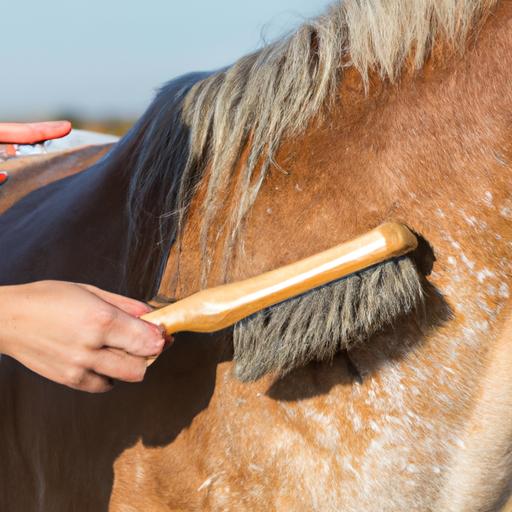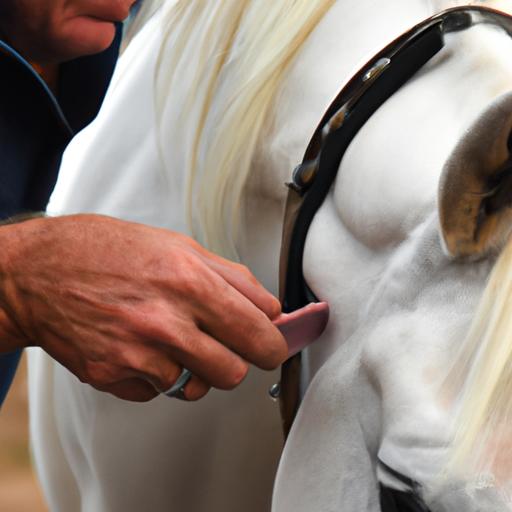Discover the best techniques and tips for effective horse care brushing. Learn how to deal with tangled hair, handle shedding seasons, and cater to sensitive skin.
Introduction

As an equestrian enthusiast, you know that caring for your horse goes beyond providing the essentials like food and shelter. One crucial aspect of horse care that often gets overlooked is brushing. Brushing not only keeps your horse’s coat radiant and beautiful but also plays a vital role in maintaining their overall well-being. In this article, we will delve into the importance of horse care brushing and explore the numerous benefits it offers.
Importance of Horse Care Brushing
Imagine going days without grooming yourself – no shower, no brushing, just neglecting your personal hygiene. Unpleasant, isn’t it? Well, horses share a similar sentiment. Regular brushing is essential for maintaining their cleanliness and comfort. It helps remove dirt, debris, and dead skin cells from their coat, preventing irritation and potential skin infections.
Moreover, brushing stimulates blood circulation, which enhances the distribution of natural oils, keeping the coat healthy and shiny. By dedicating time to brushing, you establish a bond with your horse, fostering trust and ensuring their mental well-being.
Benefits of Regular Brushing
Now, let’s unravel the array of benefits regular brushing brings to your equine companion. Firstly, it provides an excellent opportunity for you to inspect your horse’s skin for any abnormalities, such as cuts, bruises, or signs of insect bites. Early detection allows timely intervention, preventing minor issues from escalating into major health concerns.
Secondly, brushing promotes muscle relaxation and relieves tension. Similar to a soothing massage, the gentle strokes of the brush relax your horse, releasing endorphins and reducing stress levels. Additionally, brushing enhances the horse’s coat insulation, making them more comfortable during both hot and cold weather conditions.
Finally, regular brushing allows you to bond with your horse on a deeper level. It provides an intimate moment where you can communicate with your equine friend, strengthening the trust and respect between you.
So, are you ready to embark on a brushing journey that will not only keep your horse looking fabulous but also contribute to their overall happiness and health? Let’s explore the basics of horse care brushing together!
Understanding the Basics of Horse Care Brushing
Choosing the Right Brushing Tools
When it comes to brushing your horse, using the appropriate tools is paramount. The type of brush you select depends on the specific area you are grooming. Let’s explore the essential brushing tools you should have in your arsenal:
-
Curry Comb: This tool, often made of rubber or plastic, is perfect for removing loose hair, dirt, and mud from your horse’s coat. Its small, rubber teeth help stimulate the skin and promote blood circulation.
-
Body Brush: Designed with soft bristles, a body brush is ideal for removing dust and debris from your horse’s body. Its gentle strokes will leave the coat smooth and shiny. Remember, a clean horse is a happy horse!
-
Dandy Brush: With stiffer bristles, the dandy brush is excellent for removing stubborn dirt and dried sweat. It is especially useful for grooming the horse’s legs and other areas that tend to accumulate more grime.
-
Mane and Tail Comb: The long, narrow teeth of this comb make it perfect for detangling and grooming your horse’s mane and tail. Take your time to gently work through any knots or tangles, keeping your horse comfortable throughout the process.
Preparing the Horse for Brushing
Before diving into the brushing session, it is essential to prepare your horse to ensure a positive experience for both of you. Here are a few steps to follow:
-
Secure the Environment: Choose a safe and quiet area where your horse can relax during the grooming session. Make sure there are no distractions or potential hazards nearby.
-
Establish Trust: Approach your horse calmly and speak to them in a soothing tone. Gently stroke their neck and shoulder area to reassure them and establish a sense of trust.
-
Start with Familiar Areas: Begin brushing in areas your horse is familiar with, such as the neck or shoulder. This helps them ease into the grooming process and feel more comfortable.
-
Observe Your Horse’s Reactions: Pay close attention to your horse’s body language and reactions. If they show signs of discomfort or agitation, take a break or switch to a gentler brush. Your horse’s well-being should always be the top priority.
By choosing the right brushing tools and preparing your horse appropriately, you set the stage for a successful grooming session. Now that we have covered the basics, let’s move on to learning the proper techniques for horse care brushing.
Proper Techniques for Horse Care Brushing
Brushing your horse requires not only the right tools but also proper techniques to ensure a thorough and effective grooming session. Let’s explore the different aspects of horse care brushing and the techniques involved.
Brushing the Coat
When it comes to brushing the coat, start by using a soft-bristled brush to remove loose dirt and debris. Begin at the neck and move in the direction of hair growth, working your way towards the tail. Use long, sweeping strokes to cover larger areas, and pay attention to areas that are prone to sweat buildup, such as the girth area and under the mane.
For tougher dirt or mud, a rubber curry comb can be used in a circular motion to loosen and lift it from the coat. Remember to be gentle and avoid applying excessive pressure, especially on sensitive areas.
Brushing the Mane and Tail
The mane and tail require special attention to prevent tangling and promote healthy growth. Start by using a wide-toothed comb or your fingers to carefully detangle any knots or mats. Then, switch to a finer-toothed comb or a specialized mane and tail brush to remove debris and keep the hair smooth and manageable.
When brushing the mane and tail, always hold the hair at the base with one hand to avoid pulling on the roots. This minimizes discomfort and reduces the risk of hair loss. Take your time and be patient, especially if your horse has a long or thick mane.
Brushing the Hooves
Proper hoof care is essential for your horse’s overall health. Begin by gently picking out any dirt, stones, or debris from the hooves using a hoof pick. Clean from the heel towards the toe, being cautious not to damage the sensitive frog area. Regular hoof cleaning prevents the accumulation of debris that can lead to discomfort or even infections.
After cleaning, use a stiff brush to remove any remaining dirt or dust from the hoof wall and sole. This helps maintain hoof hygiene and allows you to inspect for any signs of injury or abnormalities.
Brushing Sensitive Areas
Sensitive areas such as the face, ears, and belly require extra care and attention during brushing. Use a soft-bristled brush or a damp cloth to gently clean these areas, being mindful of your horse’s comfort. Take your time and approach these areas with patience and a gentle touch to ensure a pleasant grooming experience for your equine companion.
Now that you’ve mastered the proper techniques for horse care brushing, it’s time to understand the frequency and timing of brushing to maintain a healthy and happy horse. Let’s move on to the next section and unravel the secrets of establishing a brushing routine!
Frequency and Timing of Horse Care Brushing
Establishing a Brushing Routine
Consistency is key when it comes to horse care brushing. Establishing a regular brushing routine not only ensures your horse’s coat stays in tip-top condition but also allows you to monitor their overall health. Ideally, you should aim to brush your horse at least once a day. However, the specific needs of your horse, their living conditions, and their activities will dictate the frequency.
Start by designating a specific time each day for brushing. This routine will help your horse anticipate and enjoy the grooming session. Whether it’s in the morning to prepare for the day ahead or in the evening as a wind-down ritual, find a time that works best for both of you. Consistency in your approach will make brushing a positive experience for your horse.
Determining the Optimal Brushing Frequency
While a daily brushing routine is recommended, some factors may influence the frequency of brushing sessions. Horses that spend more time outdoors or have access to sandy or muddy areas may require more frequent brushing to remove dirt and debris. Similarly, during shedding seasons, when horses naturally lose their winter coat, more frequent brushing sessions can help remove loose hairs and prevent matting.
Consider the length and thickness of your horse’s coat as well. Longer coats may require more frequent brushing to prevent tangles and keep the coat clean. Additionally, horses in strenuous training or show schedules may benefit from more frequent brushing to maintain a neat and presentable appearance.
Keep a keen eye on your horse’s coat condition and overall well-being. If you notice excessive dirt, matting, or skin irritations, it may be a sign that more frequent brushing is necessary. Conversely, if your horse’s coat remains clean and healthy with minimal grooming, you can adjust the frequency accordingly.
Remember, each horse is unique, and their brushing needs may vary. By establishing a consistent routine and adapting it to their specific requirements, you can ensure your horse’s coat remains lustrous and their well-being is maintained. So, let’s dive into the proper techniques of horse care brushing in the next section!
Conclusion
In conclusion, proper horse care brushing is an indispensable aspect of maintaining your equine companion’s well-being. By dedicating time to brushing, you not only keep their coat radiant and beautiful but also contribute to their overall health and happiness.
Regular brushing removes dirt, debris, and dead skin cells, preventing skin irritations and infections. It stimulates blood circulation, ensuring the distribution of natural oils for a healthy and shiny coat. Moreover, brushing provides an opportunity for you to bond with your horse, fostering trust and mental well-being.
Remember, consistency is key when it comes to horse care brushing. Establish a brushing routine that suits both you and your horse, and ensure you have the right tools for the job. Addressing common challenges such as dealing with tangled hair, handling shedding seasons, and providing extra care for horses with sensitive skin will help you overcome any obstacles that may arise.
At Horsemasterypro.com, we understand the importance of horse care brushing and its impact on your equine partner’s overall well-being. So, take the time to brush your horse regularly, and witness the remarkable benefits it brings to both of you. Let your horse shine with health and radiance, and strengthen the bond you share. Happy brushing!


